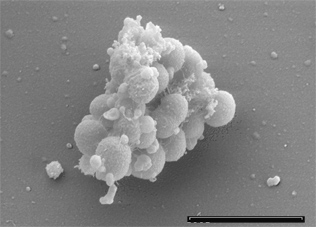User:S4354350: Difference between revisions
No edit summary |
|||
| Line 17: | Line 17: | ||
==Description and significance== | ==Description and significance== | ||
Originally identified and named as Staphylococcus parvulus by Veillon and Zuber in 1898, Veillonella parvula (V. parvula) was later renamed in 1933 by Prévot. The first experiments were performed with organisms isolated from the human mouth by Langford in 1950. | |||
Non-motile, non-sporulating, gram-negative bacteria. They grow as small cocci typically occurring as diplococci, in short chains or masses. | |||
anaerobic and microaerophilic. It fluoresces red under UV light. | |||
reduces nitrate and lactate. | |||
V. parvula is a commensal inhabitant of the oral cavity, gastrointestinal and genitourinary tract of homeothermic vertebrates. | |||
Most significant is the ability of V. parvula to form a biofilm, where it can then participate in opportunistic multispecies infections. Only rarely has V. parvula been isolated in pure culture. It has been implicated in severe infections in diverse sites such as the lungs, sinuses liver, heart, bone and central nervous system. | |||
Examples of citations <sup>[[#References|[1]]]</sup>, <sup>[[#References|[2]]]</sup> | |||
==Genome structure== | ==Genome structure== | ||
Revision as of 10:10, 22 September 2016
Name Morgan Freney Student No. 43543504 Bench ID B Date 31/08/2016 [1]
Classification
Higher order taxa
Kingdom: Bacteria, Phylum: Firmicute, Class: Negativicutes, Order: Selenomonadales, Family: Veillonellanceae, Genus: Veillonella, Species: Parvula.
In 2010, the genus Veillionella was emended by Marchandin and colleagues who reclassified all 26 genera of the Selenomonas-Megasphaera-Sporomusa group to the new order Selenomonadales in the new class Negativicutes, and divided into two families; Acidaminococcaceae and Veillonellaceae.
Species
Veillonella parvula; Prévot Te3T (= DSM 2008 = ATCC 10790 = JCM 12972)
Description and significance
Originally identified and named as Staphylococcus parvulus by Veillon and Zuber in 1898, Veillonella parvula (V. parvula) was later renamed in 1933 by Prévot. The first experiments were performed with organisms isolated from the human mouth by Langford in 1950.
Non-motile, non-sporulating, gram-negative bacteria. They grow as small cocci typically occurring as diplococci, in short chains or masses.
anaerobic and microaerophilic. It fluoresces red under UV light. reduces nitrate and lactate.
V. parvula is a commensal inhabitant of the oral cavity, gastrointestinal and genitourinary tract of homeothermic vertebrates.
Most significant is the ability of V. parvula to form a biofilm, where it can then participate in opportunistic multispecies infections. Only rarely has V. parvula been isolated in pure culture. It has been implicated in severe infections in diverse sites such as the lungs, sinuses liver, heart, bone and central nervous system.
Examples of citations [1], [2]
Genome structure
Select a strain for which genome information (e.g. size, plasmids, distinct genes, etc.) is available.
Cell structure and metabolism
Cell wall, biofilm formation, motility, metabolic functions.
Ecology
Aerobe/anaerobe, habitat (location in the oral cavity, potential other environments) and microbe/host interactions.
Pathology
Do these microorganisms cause disease in the oral cavity or elsewhere?
Application to biotechnology
Bioengineering, biotechnologically relevant enzyme/compound production, drug targets,…
Current research
Summarise some of the most recent discoveries regarding this species.
References
References examples
- ↑ MICR3004
This page is written by Morgan Freney for the MICR3004 course, Semester 2, 2016

